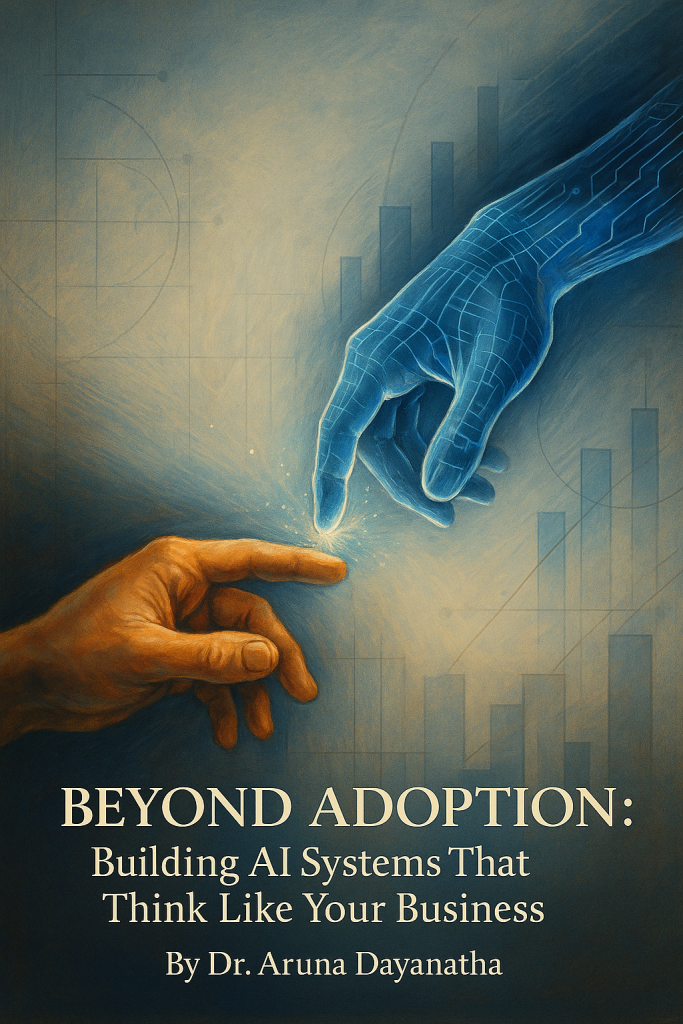By Dr. Aruna Dayanatha

Across industries, companies now proudly announce that they are adapting AI — introducing new tools, running pilot projects, and conducting tool-based training sessions for their employees.
These are valuable initiatives, but they all share a critical limitation: they focus on tools, not thinking.
Because the real question isn’t whether you’ve trained your people to use AI tools.
It’s this:
Does your AI actually think like your business?
Buying software and running workshops may signal progress, but that’s not transformation.
If your systems don’t understand the logic behind how your firm operates — how a “customer,” “transaction,” or “risk” connects to everything else — you’re automating confusion, not intelligence.
From Adoption to Alignment
Adoption is easy — it’s about installation.
Alignment is harder — it’s about integrating your company’s way of thinking into AI.
Every company’s competitive advantage lies in its unique business logic — the set of cause-and-effect rules, priorities, and decision frameworks that define how it competes, serves customers, and creates value.
This business logic is the firm’s DNA.
It isn’t written in software code — it lives in management decisions, operational nuances, and accumulated judgment.
To create real value, your AI must be trained to understand and operate within that logic.
That’s when AI becomes a strategic extension of your business thinking, not just another technology investment.
This is where business ontologies play a defining role.
An ontology is your company’s map of meaning — the structured way in which your business defines and connects its key entities.
For a bank, it might be loan → collateral → risk rating → approval threshold.
For an insurer, claim → policy → incident → payout rules.
Once defined, this logic becomes the foundation for every intelligent system — from analytics to decision-support bots.
Teaching AI to Think Like You
Three key levers help transform AI from a tool to a partner in reasoning:
1. Business Ontologies — Defining the Language of Your Firm
AI doesn’t intuitively know what “exposure,” “asset quality,” or “service breach” means in your business.
When you build and embed a business ontology, you’re teaching AI the meaning behind your terms — creating a shared understanding that makes automation intelligent and explainable.
2. Contextual Overriding — Thinking Situationally
Leaders adapt decisions to context; AI must do the same.
A rule that applies in Colombo might not hold in Dubai or Dhaka.
Through contextual overriding, AI learns to apply the right rules under the right conditions — aligning actions with geography, regulation, and client context.
3. Orchestration — Keeping Humans in Command
Leadership in the age of AI isn’t about control; it’s about orchestration.
It means coordinating humans, data, and intelligent systems into a coherent workflow — where AI amplifies expertise but humans remain accountable for judgment.
The Parallel Structure for AI Growth
Here’s a truth often missed by organizations rushing to “adopt AI”:
You can’t inject AI into existing operations and expect seamless transformation.
You need a parallel structure — a second track where AI can evolve safely while business continuity is preserved.
- The Operational Track keeps the business running.
- The AI Transformation Track experiments, learns, and matures intelligent systems.
Validated AI processes move from the transformation track into operations once they meet standards for reliability, compliance, and explainability.
This dual structure lets companies innovate boldly while maintaining control and trust.
The Leadership Shift
Tomorrow’s most valuable companies won’t be those that simply adopted AI first.
They’ll be those that taught AI how to think like their business.
The critical leadership question is no longer:
“How many AI tools do we use?”
It’s: “How well does our AI represent the way we think?”
When your AI understands your logic, it doesn’t just automate — it extends your intelligence.
It becomes a living model of how your business competes, governs, and decides.
The Road Ahead
AI transformation is not a technology project — it’s an organizational design project.
It requires leaders to translate their company’s experience, strategy, and wisdom into structured knowledge that machines can understand and execute responsibly.
That’s the work I do with leadership teams: helping them build AI architectures that think like their businesses — systems that are grounded in ontology, governed by context, and orchestrated with human judgment.
Because the future of business isn’t just intelligent —
It’s intelligently aligned.
#AITransformation #Leadership #DigitalStrategy #AIGovernance #BusinessInnovation #ArunaDayanatha
Would you like me to create a LinkedIn banner image for this article — something elegant and minimal with the title “Beyond Adoption: Buil
